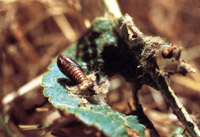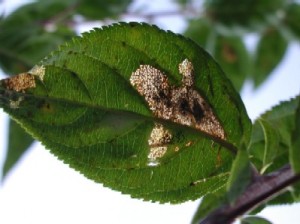Apple-and-thorn skeletonizer
Howard Russell, Sarah Hughson
Apple-and-thorn skeletonizer
Apple-and-thorn skeletonizer (Choreutis pariana, AATS) is a little known, tiny caterpillar was a widespread pest of ornamental crabapple trees 15 years ago. But since then, it has virtually disappeared from the local landscape. Besides crabapple, it also feeds on apple, birch, cherry, hawthorn, willow and mountain ash. This insect is known to occur from Virginia to northern California and north into parts of Canada. It is reported to be a serious pest of commercial apple orchards in British Columbia. The adult is a rather pretty little moth about 1/4 of inch long with the wings brown with hints of gray and somewhat sculpted at the tips. The wings are held flat over the abdomen in a distinctive “V” or delta-shaped posture. The AATS develops from egg to adult very quickly and four generations may occur in a single season. In the spring, the overwintering moths begin to lay eggs shortly after the leaves unfold. After hatching, the tiny caterpillar begins feeding on the lower surface of the leaf under a loose covering of silk. Later, it moves to the upper surface where it ties the edges of the leaf together, forming a protective shelter. Here the caterpillar feeds on the tissue between the veins giving the leaf a lace-like or “skeletonized” appearance. Severely damaged leaves may prematurely drop from the tree. During warm weather, the AATS may complete its life cycle in 30 days or less.
Chemical control of this insect is not recommended because it is well controlled by natural enemies and pesticide applications for other pests like codling moth and apple maggot. There are no pesticides currently labeled for control of this pest and broad spectrum applications should be avoided because they kill the natural enemies.




Original article by Howard Russell
Article reviewed by Sarah Hughson, May 2025
Resources:
Pacific Northwest Pest Management Handbooks. Apple-and-thorn skeletonizer.



 Print
Print Email
Email




